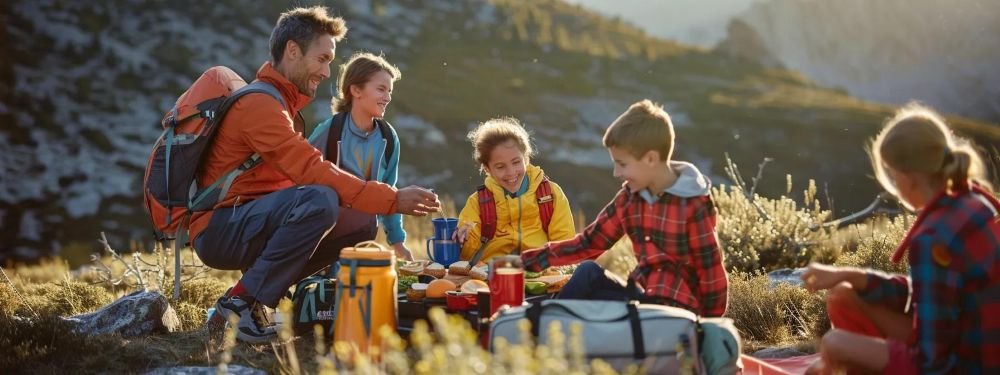Physical Address
304 North Cardinal St.
Dorchester Center, MA 02124


Planning Your Eco-Conscious Family Adventure
Are you looking for ways to make your family trips more meaningful while teaching your children to love and protect our planet? Sustainable travel tips for families have become essential in today’s world, where conscious tourism can make a real difference.
Table of Contents
Picture this: Your seven-year-old daughter spots a sea turtle while snorkeling in crystal-clear water. Her eyes are wide with wonder. This moment becomes even more precious when you realize that your family’s travel choices helped preserve the turtle’s habitat. Sustainable family travel isn’t just about reducing our carbon footprint; it’s also about forming deeper connections with our destinations and ensuring that future generations can experience the same magic.
The problem is clear. Mass tourism significantly contributes to environmental degradation, and families often unknowingly engage in practices that harm local ecosystems. According to the International Civil Aviation Organization, the aviation industry alone accounts for approximately 2.5% of global carbon emissions.
This situation becomes even more urgent when we realize that our children are watching and learning from our travel habits. They absorb our values through our actions, so every family trip becomes a valuable opportunity to teach environmental responsibility.
The solution lies in embracing sustainable travel practices for families that balance adventure with environmental consciousness. By making thoughtful choices, families can explore the world while contributing positively to destinations and communities.
Successful, sustainable family travel begins long before you pack your bags. The planning phase establishes the foundation for an eco-friendly adventure that excites parents and children alike.
Start by involving your kids in researching potential destinations. Create a family vision board featuring places where wildlife thrives, communities welcome visitors warmly, and natural beauty remains unspoiled. This collaborative approach will build excitement while teaching your children about global ecosystems and cultures.

Start by involving your kids in researching potential destinations
Research destinations that actively promote sustainable tourism. Look for countries with robust environmental protection policies, community-based tourism initiatives, and eco-certification programs. For example, Costa Rica generates over 99% of its electricity from renewable sources and offers incredible biodiversity for families to responsibly explore.
Carefully consider the timing of your travels. Shoulder seasons often offer better weather, smaller crowds, and a lower environmental impact. Additionally, traveling during off-peak times typically costs less, making sustainable travel more affordable for families on a budget.
Using digital planning tools can significantly reduce paper waste. Use smartphone apps for itineraries, mobile boarding passes, and digital maps. Teach your children to use these tools and turn technology into an ally for environmental protection.
Research the environmental challenges your destination faces. Families can make informed decisions during their trip by understanding issues like water scarcity, waste management, and endangered species.
Connect with local environmental organizations or community groups on social media. Many destinations have grassroots organizations that welcome families to volunteer for activities such as beach cleanups, tree planting, and wildlife monitoring.
Book accommodations and activities through certified sustainable tourism operators. Look for certifications from organizations such as the Global Sustainable Tourism Council or local ecotourism boards.
Sustainable destinations for families provide rich experiences while upholding strong environmental and social responsibility practices. They actively work to preserve their natural beauty and cultural heritage for future generations.
The Nordic countries consistently rank among the most sustainable destinations. In Finland’s Lapland region, families can witness the Northern Lights and learn about Sami culture and Arctic conservation efforts. Children can participate in reindeer herding activities that support traditional livelihoods and contribute to landscape preservation.

In Finnish Lapland, families can see the Northern Lights.
New Zealand is known for its comprehensive approach to sustainable tourism. Through the “Tiaki Promise,” the country encourages visitors to care for the land, sea, and culture. Families can explore pristine national parks, learn about Māori traditions, and participate in conservation programs tailored to young visitors.
Bhutan’s unique “Gross National Happiness” philosophy prioritizes environmental conservation and economic development. This carbon-negative country limits the number of tourists, ensuring minimal environmental impact while providing families seeking meaningful travel with authentic cultural experiences.
Slovenia is emerging as Europe’s green secret. Over 60% of its territory is covered by forests. Lake Bled offers family-friendly hiking trails, traditional wooden boats powered by human energy, and locally sourced cuisine that supports regional farmers.Click here
Rwanda has transformed from a conflict-stricken country to a model of sustainable development. Families can participate in gorilla trekking programs that fund conservation efforts and provide unforgettable wildlife encounters. This experience teaches children about species preservation and community resilience.
Madagascar offers families the opportunity to explore unique ecosystems and support local conservation efforts. Many lodges offer educational programs in which children can learn about endemic species, such as lemurs, and participate in reforestation projects.
Your family’s transportation choices significantly impact its travel carbon footprint. For families, sustainable transportation requires balancing practicality with environmental responsibility, especially when traveling with children of different ages.
For many destinations, rail travel is an excellent alternative to flying. Train journeys are adventures in themselves. Children can enjoy scenic views and learn about different landscapes and communities. The Orient Express route through Europe offers luxury family compartments and generates significantly fewer emissions than equivalent flights.
Choose direct flights whenever possible when flying becomes necessary. Takeoffs and landings produce the highest emissions, so reducing connections minimizes environmental impact. Many airlines now offer carbon offset programs designed for families that allow you to neutralize your flight’s environmental impact by supporting verified conservation projects.
Rentals of electric vehicles are becoming increasingly available in major tourist destinations. Countries such as Norway, the Netherlands, and Iceland have extensive charging networks that make electric road trips feasible for families. The quiet operation of electric vehicles enhances wildlife viewing opportunities and reduces noise pollution in natural areas.
Public transportation systems often provide an authentic local experience while reducing one’s carbon footprint. Teaching children to navigate metro systems, buses, and local trains can build their confidence and cultural awareness, all while supporting sustainable urban mobility.
Cycling tourism has exploded at family-friendly destinations around the world. Many cities now offer bike rental services for families, complete with child seats, trailers, and helmets. Thanks to its extensive cycling infrastructure, Copenhagen makes it easy for families to explore the city sustainably while enjoying Danish hygge culture.
Walking tours designed for families combine exercise and education. Many destinations offer scavenger hunt–style walking tours that engage children while teaching them about local history, architecture, and environmental features.
Eco-friendly family accommodations go far beyond simple recycling programs. These establishments integrate sustainability into every aspect of their operations, providing comfortable and safe environments for families.
Eco-lodges designed specifically for families offer a unique opportunity to experience nature while minimizing environmental impact. The Galapagos Islands have several such lodges that use renewable energy, naturally treat wastewater, and employ local guides who share their extensive knowledge of endemic species with young visitors.
Farm stays connect families with sustainable agricultural practices and provide hands-on learning experiences. Children can collect eggs, milk goats, and harvest vegetables, all while learning about organic farming, seasonal eating, and rural lifestyles. These experiences are often more memorable than traditional resort stays.
Urban eco-hotels are increasingly catering to families by offering organic breakfast options, energy-efficient room systems, and partnerships with local environmental organizations. Many also offer programs for families, including urban gardening workshops, recycling education, and city nature walks.
Home exchanges eliminate the need for new construction while offering an authentic local experience. Families can experience daily life in different cultures while enjoying familiar comforts for their children. Platforms like HomeExchange specialize in family-friendly exchanges and have detailed profiles and safety verification processes.
Camping and glamping options have evolved to accommodate families seeking outdoor experiences that don’t sacrifice comfort. Now, many campgrounds offer eco-friendly amenities, such as composting toilets and solar showers, as well as nature education programs designed for different age groups.
Vacation rental properties that have sustainability certifications offer families space to prepare local meals, which reduces restaurant waste and allows them to explore regional cuisine. Look for properties with energy-efficient appliances, water conservation systems, and recycling facilities.

Environmental conservation activities and experiences
Sustainable family activities create lasting memories and contribute positively to destinations and local communities. These activities teach children about environmental stewardship and provide them with engaging, age-appropriate adventures.
Certified wildlife viewing activities supported by conservation organizations ensure ethical animal encounters while promoting protection efforts. Many programs specifically welcome families and provide educational components that help children understand animal behavior, habitat requirements, and conservation challenges.
Community-based tourism experiences allow families to authentically engage with local cultures while directly supporting community development. Activities such as participating in traditional craft workshops, taking cooking classes that use local ingredients, and attending cultural festivals provide insights into local life while generating income for residents.
Designed for families, volunteer tourism opportunities combine travel with meaningful service. These programs include beach cleanup initiatives, tree planting projects, and educational support activities. They allow families to contribute tangibly to their destinations while teaching children about global citizenship.
Visiting museums with environmental themes provides learning opportunities regardless of weather conditions. The Natural History Museum in London, the California Academy of Sciences, and the Singapore Science Centre, for example, offer interactive exhibits that engage children while teaching them about biodiversity, climate change, and conservation solutions.
Guided nature walks led by local naturalists offer expert insights into local ecosystems and support environmental education. Many destinations offer specialized family programs that combine hiking with activities such as wildlife spotting, plant identification, and explanations of ecosystems, all of which are appropriate for different age levels.
Agricultural experiences allow families to learn about food production and support sustainable farming practices. Participating in olive harvests in Mediterranean countries, visiting coffee plantations in Central America, and picking organic wine grapes in various regions provides hands-on learning about sustainable agriculture.
Smart packing reduces environmental impact while ensuring the comfort and safety of your family during travel. For families, sustainable packing requires the thoughtful selection of versatile, durable items that serve multiple purposes.
Having a reusable water bottle for each family member eliminates the need for single-use plastic bottles and ensures that everyone stays hydrated. Stainless steel bottles are ideal for active families because they maintain temperature control and are durable. Collapsible silicone bottles save space in luggage.

reusable water bottle
Using biodegradable toiletries helps protect water systems in destinations with limited wastewater treatment infrastructure. Many eco-friendly brands now offer family-sized and travel-sized options that meet airline regulations while maintaining environmental standards.
Clothing made from quick-drying, sustainable materials reduces the need for frequent laundry and water consumption while traveling. Merino wool and bamboo fiber options are naturally odor-resistant, making them ideal for active families exploring outdoor destinations.
Portable water filtration systems allow families to safely drink from various sources, eliminating their dependence on bottled water. Modern filtration bottles and UV sterilization devices are lightweight and effective for most travel destinations.
Using reusable food containers and utensils instead of single-use plastic during picnics, takeout meals, and snack times helps reduce plastic consumption. Durable stainless steel and bamboo options are easy to clean and safe for children to use independently.
Eco-friendly sunscreen protects your family’s skin and marine ecosystems. Reef-safe formulas avoid chemicals that harm coral while providing the necessary UV protection for outdoor activities.
Understanding and respecting local cultures enhances travel experiences and supports community preservation. Cultivating cultural awareness fosters positive interactions and meaningful connections across cultures, creating sustainable families.
Research the cultural norms regarding appropriate behavior, dress codes, and social interactions before you arrive. Teaching children about these differences fosters respect and adaptability, and prevents unintentional offense. Many cultures have specific protocols for interacting with children, religious sites, and natural areas.
Focus on learning basic phrases in the local languages, particularly polite expressions and environmental terms. Children often excel at learning languages, and residents typically appreciate their efforts to communicate in their native languages. Simple phrases related to recycling, conservation, and appreciation for nature can spark meaningful conversations.
Understand the local environmental challenges and cultural attitudes toward conservation. Keep in mind that some destinations may have different approaches to waste management, water conservation, and wildlife protection based on cultural values, economic constraints, and historical experiences.
Support local artisans and businesses that practice sustainability. Before making purchases, research fair trade certification, local ownership, and environmental policies. Teaching children to evaluate products based on these criteria fosters critical thinking about consumption.
When invited, participate in local festivals and celebrations while maintaining respectful boundaries. Many communities welcome visitors who show a genuine interest in cultural traditions, especially when families participate with their children in a respectful manner.
Responsibly document your travels by asking permission before photographing people, respecting photography restrictions at cultural sites, and avoiding intrusive behavior during private or religious activities.
Strategic planning and conscious choices can make affordable, sustainable travel possible for families, often providing richer experiences than conventional tourism approaches.
Traveling during the shoulder season offers significant cost savings while reducing environmental impact due to lower tourist volumes. Popular destinations like Greece in the spring, Japan in the early fall, and Thailand during the cool season offer excellent weather, lower prices, and more authentic interactions with the locals.
Slow travel approaches reduce transportation costs while allowing for a deeper exploration of destinations. By staying longer in fewer places, families can avoid frequent packing, reduce transportation expenses, and discover local neighborhoods, markets, and natural areas that day-trip tourists miss.
Free and low-cost activities often provide the most sustainable and memorable experiences. National parks, public beaches, local festivals, and community events are usually inexpensive and support conservation and local culture. Many cities offer free walking tours, museum days, and outdoor concerts that are family-friendly.
Sharing accommodations reduces costs while minimizing resource consumption. Families can rent larger spaces that accommodate multiple families, splitting the cost while maintaining privacy. Vacation rental properties often have kitchens, so families can shop at local markets and cook with regional ingredients.
Public transportation passes usually cost less than taxi services and provide an authentic local experience. Many cities offer family-friendly passes that include additional benefits, such as discounts to museums or access to cultural sites.
Shopping at local markets provides access to fresh, affordable ingredients while supporting regional agriculture. Teaching children to select seasonal produce, negotiate respectfully with vendors, and appreciate local food traditions fosters the development of valuable life skills and reduces food costs.
Safety is paramount when incorporating sustainable travel practices for families. Proper planning and awareness can ensure environmental consciousness and family security work together.
Familiarize yourself with the health and safety requirements of eco-friendly destinations, paying particular attention to water quality, food safety, and medical facilities. Since remote eco-lodges may have limited medical access, comprehensive travel insurance and basic first aid knowledge are essential for families.
Familiarize yourself with wildlife safety protocols for destinations featuring animal encounters. Teaching children how to behave around wildlife protects both the animals and your family while improving your observation experience. Many conservation areas offer family-friendly safety briefings that combine education with protection guidelines.
Environmental hazards in natural destinations require preparation and awareness. For example, coastal areas may have strong currents, mountain regions may experience rapid weather changes, and tropical locations may have venomous species or disease vectors. Therefore, precautionary measures are necessary.
Create emergency communication plans that account for limited connectivity in remote, sustainable destinations. Families visiting isolated eco-lodges or participating in wilderness conservation programs may need satellite communication devices.
Pack a comprehensive first aid kit with supplies appropriate for your activities and destinations. Include medications for common travel ailments and insect bites or stings, as well as supplies for minor cuts and scrapes that may occur during outdoor activities.
Register with the appropriate government agencies when traveling to remote or potentially unstable regions. Many countries offer services that allow citizens to register and receive safety updates and emergency assistance coordination while abroad.
How can families effectively offset their travel carbon footprint? First, calculate your family’s travel emissions using a reputable online calculator. Then, invest in verified carbon offset programs that focus on renewable energy, forest conservation, or community development projects. Many programs allow you to see exactly how your contribution supports environmental protection.
Which destinations are the best for sustainable tourism with young children? Costa Rica, New Zealand, and Denmark are consistently ranked among the best for family-friendly, sustainable tourism. These countries offer excellent healthcare and environmental education programs, as well as infrastructure designed to accommodate families while maintaining strong conservation practices.
How can we find authentic, eco-friendly accommodations? Look for certifications from recognized organizations, such as the Global Sustainable Tourism Council. Research property sustainability practices on their websites and read reviews from other families. Many eco-lodges have detailed environmental and social responsibility reports available to potential guests.
Is sustainable travel more expensive for families? Although some eco-friendly options may be more expensive initially, sustainable travel often results in lower overall expenses due to reduced consumption, longer stays in fewer destinations, and activities centered on nature and culture rather than costly attractions. Many families find that sustainable travel provides better value through richer experiences.
How can we prepare children for sustainable travel experiences? We can do this by involving them in destination research, teaching them about local environmental challenges, practicing sustainable habits at home, and setting clear expectations about the different living conditions and cultural practices they may encounter while traveling.
Are you ready to transform your family travels into meaningful adventures that protect our planet while creating lifelong memories? Start planning your sustainable family vacation today. Explore eco-certified accommodations and conservation-focused activities at your dream destination.
Share your family’s experiences with sustainable travel in the comments below. Your stories may inspire other families to embark on their own eco-friendly adventures and show your children that they can explore the world and care for it at the same time.
This article is a travelgoeasy.net exclusive, and its content is protected from copying and unauthorized use.
Start planning your sustainable family vacation today. Explore eco-certified accommodations and conservation-focused activities at your dream destination.
Discover how our comprehensive solutions empower your journey.
Trip & Tricks
Have you ever felt that unmistakable pull of the open road, the desire to leave the familiar behind and watch the world change outside your car window? A USA road trip itinerary isn’t just a vacation, it’s a modern-day pilgrimage
Honeymoon Getaways
Imagine yourselves, hand in hand, strolling along powdery white sand beaches as the sun dips below the horizon, painting the sky in fiery hues.




